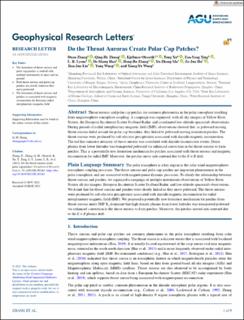| dc.contributor.author | Zhang, Duan | |
| dc.contributor.author | Zhang, Qing-He | |
| dc.contributor.author | Oksavik, Kjellmar | |
| dc.contributor.author | Xu, Tong | |
| dc.contributor.author | Xing, Zan-Yang | |
| dc.contributor.author | Lyons, L.R. | |
| dc.contributor.author | Han, De-Sheng | |
| dc.contributor.author | Zhang, Hong-Bo | |
| dc.contributor.author | Ma, Yu-Zhang | |
| dc.contributor.author | Hu, Ze-Jun | |
| dc.contributor.author | Liu, Jian-Jun | |
| dc.contributor.author | Wang, Yong | |
| dc.contributor.author | Wang, Xiang-Yu | |
| dc.date.accessioned | 2024-03-19T13:48:44Z | |
| dc.date.available | 2024-03-19T13:48:44Z | |
| dc.date.created | 2023-05-11T10:23:32Z | |
| dc.date.issued | 2023 | |
| dc.identifier.issn | 0094-8276 | |
| dc.identifier.uri | https://hdl.handle.net/11250/3123165 | |
| dc.description.abstract | Throat auroras and polar cap patches are common phenomena in the polar ionosphere resulting from magnetosphere-ionosphere coupling. A campaign was organized, with all-sky imagers at Yellow River Station, the European Incoherent Scatter Svalbard Radar, and coordinated low-altitude spacecraft observations. During periods of radial interplanetary magnetic field (IMF), observations showed that, as poleward moving throat auroras faded around the polar cap boundary, they linked to poleward moving ionization patches. The throat auroras were produced by soft-electron precipitation associated with dayside magnetic reconnection. The red line emission intensity of throat auroras was correlated with dayside reconnection events. Dense plasma from lower latitudes was transported poleward via enhanced convection in the throat auroras to form patches. This is a potentially new formation mechanism for patches associated with throat auroras and magnetic reconnection for radial IMF. Moreover, the patches move anti-sunward due to the E × B drift. | en_US |
| dc.language.iso | eng | en_US |
| dc.publisher | AGU | en_US |
| dc.rights | Attribution-NonCommercial-NoDerivatives 4.0 Internasjonal | * |
| dc.rights.uri | http://creativecommons.org/licenses/by-nc-nd/4.0/deed.no | * |
| dc.title | Do the Throat Auroras Create Polar Cap Patches? | en_US |
| dc.type | Journal article | en_US |
| dc.type | Peer reviewed | en_US |
| dc.description.version | publishedVersion | en_US |
| dc.rights.holder | Copyright 2023 The Author(s) | en_US |
| dc.source.articlenumber | e2022GL102263 | en_US |
| cristin.ispublished | true | |
| cristin.fulltext | original | |
| cristin.qualitycode | 2 | |
| dc.identifier.doi | 10.1029/2022GL102263 | |
| dc.identifier.cristin | 2146877 | |
| dc.source.journal | Geophysical Research Letters | en_US |
| dc.relation.project | Norges forskningsråd: 326039 | en_US |
| dc.relation.project | Norges forskningsråd: 223252 | en_US |
| dc.identifier.citation | Geophysical Research Letters. 2023, 50 (7), e2022GL102263. | en_US |
| dc.source.volume | 50 | en_US |
| dc.source.issue | 7 | en_US |

